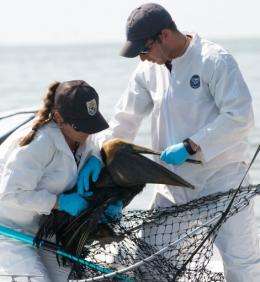'Fifty percent of spilled oil remains in Gulf' (Update)

Over half the oil released from a busted BP well remains in the Gulf of Mexico, a presidential panel has been told, contrary to government claims, as the US pointman lamented a "dysfunctional" response to the disaster.
Interior Secretary Ken Salazar meanwhile told the bipartisan commission the spill had bolstered a drive to reform federal regulations for offshore drilling, promising that lessons were learned with a moratorium still in place.
In an ominous sign for residents of states on the Gulf of Mexico, however, oceanographer Ian MacDonald said that while much of the oil was dispersed, evaporated or removed by burning and skimming, "the remaining fraction -- over 50 percent of the total discharge -- is a highly durable material that resists further dissipation."
The assessment implied some 2.5 million barrels of oil -- or 105 million gallons -- was still embedded in the fragile ecosystem, out of the estimated 4.9 million barrels that gushed into the Gulf during the 87 days before the well was capped.
"Much of it is now buried in marine and coastal sediments," MacDonald warned, adding there was "scant evidence for bacterial degradation of this material prior to burial."
His analysis presented to the panel stood in contrast to a more encouraging official report in early August that claimed some 75 percent of the oil spilled from the well had disappeared.
Retired coast guard admiral Thad Allen, US pointman for the spill response, earlier acknowledged how confusion, from both the US public and local public officials, over who was in charge of the response meant "procedures that worked terrific for the last 20 years became dysfunctional."
Efforts to prevent oil from washing onto the fragile Gulf Coast, cap the flow of crude and clean it off the shoreline were all impacted by the confusion, Allen said.
But Doug Suttles, BP's chief operating officer for exploration and production and one of the most public faces of the energy giant throughout the crisis, insisted there was no mistaking who made the calls.
"It was always clear to me that the Coast Guard was in charge," he said.
Billy Nungesser, the outspoken president of Plaquemines Parish in southern Louisiana, told the panel the problem persists months after the oil has stopped flowing: "This late in the day, I still can't tell you who's in charge."
Known for passionate tirades against the government and BP as the spill impacted the local economy and coastline, the rotund Nungesser appeared a world away from the muggy swamp lands of his home district when he spoke forcibly to the panel in a luxury Washington hotel conference room.
"I'm still angry," he reminded the commission, saying the fight for survival in his community remains, with residents struggling to get back on their feet.
Hundreds of miles of coastline from Texas to Florida were sullied by the devastating spill, in the wake of the April 20 explosion that crippled BP's Deepwater Horizon drilling rig off Louisiana, killing wildlife and choking local communities that rely on industries such as tourism and fishing.
The controversial use of chemical dispersants in a bid to break down or suppress the oil from the reaching the surface prompted intense internal discussion, US Coast Guard Rear Admiral Mary Landry told the panel.
While US officials "absolutely felt there could be a reduction" in their use, it was decided in the early weeks of the spill there was a greater need to mitigate the coastal impact and amount of oil at the Deepwater Horizon site.
"Over time, we met that goal of reducing dispersants," she said.
When authorities managed to cap the well after more than 12 weeks, however, some 1.8 million gallons of of the chemicals had been used.
Dispersants were deemed "generally less toxic than oil... and has been known to biodegrade over days and weeks, much quicker than the oil," Environmental Protection Agency Administrator Lisa Jackson said.
The long-term effects of their use and the massive quantities in which they were employed still "warrant caution," Jackson warned the commission.
Earlier this month US officials declared the broken well to be finally capped, but BP still faces a long uphill battle to clean up the Gulf, along with a litany of lawsuits, billions of dollars in fines, and shareholders angered by the firm's instability after its share price more than halved.
BP has pledged to continue "remedying the harm that the spill caused to the Gulf of Mexico, the Gulf Coast environment and to the livelihoods of the people across the region."
(c) 2010 AFP





















